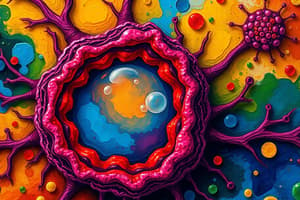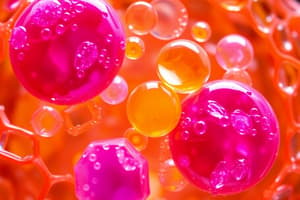Podcast
Questions and Answers
¿Cuál de los siguientes niveles de organización biológica representa una agrupación de células que trabajan juntas para realizar una función específica?
¿Cuál de los siguientes niveles de organización biológica representa una agrupación de células que trabajan juntas para realizar una función específica?
En la clasificación de los niveles de organización, ¿cuál es el nivel que viene inmediatamente después de los órganos?
En la clasificación de los niveles de organización, ¿cuál es el nivel que viene inmediatamente después de los órganos?
¿Qué característica de la microgreenhouse contribuye a la optimización del crecimiento celular?
¿Qué característica de la microgreenhouse contribuye a la optimización del crecimiento celular?
¿Cuál de las siguientes opciones representa una característica esencial de las células en organismos multicelulares?
¿Cuál de las siguientes opciones representa una característica esencial de las células en organismos multicelulares?
Signup and view all the answers
¿Qué nivel de organización incluye tanto células como tejidos y órganos?
¿Qué nivel de organización incluye tanto células como tejidos y órganos?
Signup and view all the answers
What is the primary role of the microgreenhouse in cellular biology?
What is the primary role of the microgreenhouse in cellular biology?
Signup and view all the answers
Which of the following best describes the cellular organization in multicellular organisms?
Which of the following best describes the cellular organization in multicellular organisms?
Signup and view all the answers
At which level of biological organization do organisms function as a whole?
At which level of biological organization do organisms function as a whole?
Signup and view all the answers
What characteristic distinguishes multicellular organisms from unicellular organisms?
What characteristic distinguishes multicellular organisms from unicellular organisms?
Signup and view all the answers
Which of the following is NOT a benefit of using a microgreenhouse for cellular growth?
Which of the following is NOT a benefit of using a microgreenhouse for cellular growth?
Signup and view all the answers
Study Notes
Cell Biology Questionnaire: Micro Greenhouses
-
Cell Structure and Function: Cells are the fundamental units of life. Different cell types exhibit varying structures, reflecting their specialized functions.
- Plant cells and animal cells differ significantly in their structures, with plant cells possessing cell walls, chloroplasts, and large vacuoles, features absent in animal cells.
- Animal cells typically have more complex internal structures for specialized processes.
- A generalized animal cell includes a cell membrane, cytoplasm, nucleus with DNA, mitochondria for energy production, endoplasmic reticulum for protein synthesis and modification, Golgi apparatus for packaging proteins, ribosomes for protein synthesis, and lysosomes for digestion.
- Plant cells have all of the above, plus cell walls, chloroplasts (for photosynthesis), and large central vacuoles.
- Images of various cell types (e.g., plant, animal, bacterial) should be included in the questionnaire, highlighting specific organelles.
Micro Greenhouses (Grow Labs)
-
Microclimate Control: Micro greenhouses, or grow labs, are controlled environments allowing specific environmental conditions to be maintained for optimal plant growth, irrespective of the outdoor conditions.
- These controlled environments precisely manage factors affecting plant growth, including light intensity, temperature, humidity, and CO2 levels.
- The microclimate regulation permits faster growth and higher yields of various vegetables, herbs, or fruits.
- Precise control enhances the quality of produce.
- Optimizing growing conditions can lead to higher yields and potentially increased nutritional value.
-
Environmental Parameters: Maintaining optimal environmental conditions is crucial in micro greenhouses.
- Light intensity and spectrum are critical factors affecting photosynthesis and plant growth. Grow lights with adjustable light spectrums help plants to grow at ideal levels.
- Temperature regulation is key in optimal plant growth. Fluctuations can inhibit metabolic processes. Grow lights also generate heat that influences temperature.
- Humidity control impacts transpiration and water uptake in plants.
- Carbon dioxide (CO2) enrichment can stimulate photosynthesis and boost yields. CO2 levels influence photosynthesis rates and are often enhanced in grow labs.
- Automated systems control environmental parameters using sensors and actuators.
-
Types and Design: Micro greenhouses can take diverse forms, from small, DIY set-ups to complex commercial systems.
- Different designs exist, with portable and fixed structures available to accommodate specific needs and budgets.
- Efficient ventilation systems and appropriate insulation are crucial components for many.
Levels of Organization in Biology
-
Cellular Level: Cells are the fundamental units of life, possessing specialized structures and functions.
- Cells are the basic organizational unit for all living things.
- Specialized cells, grouped together to form tissues and further, function together in organs.
- Individual cells perform unique functions necessary for life.
-
Tissue Level: Tissues are groups of similar cells that perform a specific function, such as muscle, nerve, or connective tissues.
- Tissues are groups of cells with similar structure and function.
- They work together to perform specific tasks in the organism.
- Examples include muscle tissue, nerve tissue, connective tissue, and epithelial tissue.
-
Organ Level: Organs are composed of different tissues working together to perform a specific task, e.g., the heart, lungs, or stomach.
- Organs are composed of multiple tissues.
- They perform specific functions in the organism.
- Examples include the heart, lungs, stomach, and kidney.
-
Organ System Level: Organ systems are groups of organs that work together to perform a major body function, e.g., digestive, respiratory, or circulatory systems, etc
- Organ systems are composed of multiple organs working together for a similar body function, such as digestion, breathing, or circulating blood.
- Examples include the digestive system, respiratory system, and circulatory system.
-
Organism Level: The organism level encompasses the complete living being, like a plant or an animal.
- An individual living thing, like an organism, with all levels working together, from cells to organ systems.
- Includes all the interacting organ systems for biological function
- Individual organisms demonstrate the properties of organization, metabolism, response to stimuli, reproduction, and adaptation.
- Interactions between the cellular, tissue, organ, and organ system levels, as well as species differences, should be explored.
-
Ecosystem (and Beyond): Organisms interact with their environment forming complex ecosystems.
- Expanding beyond the organismal level, the interactions of a living being with its physical environment.
- This includes interactions with other organisms, and environmental factors such as climate and resources.
- This creates a dynamic system of interdependence.
Studying That Suits You
Use AI to generate personalized quizzes and flashcards to suit your learning preferences.
Description
Realiza este cuestionario para evaluar tu comprensión sobre los niveles de organización biológica, desde las células hasta los órganos. Aprenderás qué características son esenciales en las células de organismos multicelulares y cómo se optimiza el crecimiento en micro invernaderos.




